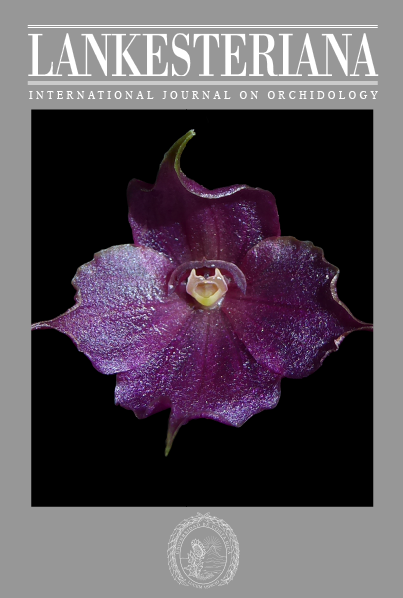A new species of <i>Brachionidium</i> (Pleurothallinidae) from the Yanachaga Chemillen National Park, Pasco, Peru
DOI:
https://doi.org/10.15517/lank.v23i3.58033Keywords:
bidentate stigma, biosphere reserve Oxapampa–Ashaninka–Yanesha, Brachionidium montieliae, claviform pollinia (8), trapezoid callus, wet puna forestAbstract
A new Brachionidium from Peru is described and illustrated based on living plants. Information on distribution, ecology, etymology, and phenology is also included. The new species, B. montieliae, was discovered in one of the highest mountains of the Oxapampa-Ashaninka-Yanesha Biosphere Reserve (BIOAY), situated above the forests of the Humid Puna of the Yanachaga Chemillen National Park at 3590 m in elevation. It is similar to Brachionidium vasquezii but differs in the oblong-elliptic, denticulate, and semi-erect leaves, somewhat lanuginose abaxially; the purple lanuginose adaxially and papular abaxially, entire, acuminate lateral sepals; the purplish oblong-ovate dorsal sepal, lanuginose on the adaxial surface, papular abaxially; the purple petals with scalloped edges, acuminate to obtuse apex ending in a thin, slightly abbreviated tail; the lip with apiculate lateral angles and with a central, trapezoid verrucose callus on the disc. Brachionidium montieliae is a terrestrial species that thrives in the humid Puna forests at elevations around 3400–3600 meters. The ecosystem is characterized by a sclerophyllous forest with a diverse range of tree species. The species typically blooms between July and August. There are potential threats from annual burning practices in the region. Given the potential risks, it is imperative to undertake immediate conservation measures and promote environmental awareness to safeguard this species.Downloads
References
Bánki, O., Roskov, Y., Döring, M., Ower, G., Hernández Robles, D. R., Plata Corredor, C. A., Stjernegaard Jeppesen, T., Örn, A., Vandepitte, L., Hobern, D., Schalk, P., DeWalt, R. E., Ma, K., Miller, J., Orrell, T., Aalbu, R., Abbott, J., Adlard, R., Adriaenssens, E. M., et al. (2023). Catalogue of Life Checklist (Version 2023-10-16). Catalogue of Life. https://doi.org/10.48580/df7lv
Becerra, E. (2005). El género Brachionidium (Orchidaceae) en el Perú. Tres especies nuevas para la selva central peruana. Arnaldoa, 12(1–2), 54–61.
Becerra, E. & Catchpole, D. J. (2007). The genus Brachionidium Lindl. (Orchidaceae) in Peru with a new species endemic to the Selva Central. Lindleyana, 76(17), 937–939.
Bogarín, D., Karremans, A. P. & Muñoz García, M. (2015). Brachionidium kirbyi, eine neue Art zu Ehren des Gründers des Orchideenprojektes “Bosque de Paz” in Costa Rica. Die Orchidee, 66, 404–409.
Bogarín, D. & Karremans, A. P. (2016). A New Brachionidium (Orchidaceae: Pleurothallidinae) from the First Botanical Expedition to the Volcán Cacho Negro, Costa Rica. Systematic Botany, 41(4), 919–923.
Garay, L. A. (1956). Studies in American orchids, II. The genus Brachionidium Lindl. Canadian Journal of Botany, 34, 721–743.
GBIF Secretariat (2023). GBIF Backbone Taxonomy. Brachionidium Lindl. in Checklist dataset https://doi.org/10.15468/39omei accessed via GBIF.org on 2023-11-23.
Goicochea, R., A., Gutiérrez R., A.D., Ruiz R., A. & Salas G., M. (2019). Orquídeas de Perú: Relación de especies y sus sinónimos. Corporación G y G, Moyobamba, Perú. 288 pp.
IPNI. (2023). The International Plant Names Index. Retrieved from http://www.ipni.org/ Accessed on March 2023.
Jiménez, P. I. (2015). Orquídeas de Bolivia y Perú, Novedades taxonómicas I (Pleurothallinidae). Lankesteriana, 15(3), 187–204.
Lindley, J. A. (1859). Brachionidium. In: J. Matthews (Ed.), Folia Orchidacea. An Enumeration of the Known Species of Orchids (Fasc. 8–9). London: Bradbury & Evans.
Luer, C. A. (1995). Icones Pleurothallidinarum XII. Systematics of Brachionidium and addenda to Dresslerella, Platystele and Porroglossum (Orchidaceae). Monographs in Systematic Botany From the Missouri Botanical Garden, 57, 1–138.
Luer, C. A. (2010). Icones Pleurothallidinarum XXXI. Addenda: new species of Brachionidium, Lepanthes, Masdevallia, Octomeria, Platystele, Pleurothallopsis and Porroglossum. Monographs in Systematic Botany from the Missouri Botanical Garden, 120, 137–153.
Luer, C. A. & Thoerle, L. (2012). Miscellaneous new species in the Pleurothallidinae (Orchidaceae). Harvard Papers in Botany, 17, 333–368.
Pridgeon, A. M. (2005). Brachionidium. In: A. M. Prigeon, P. J. Cribb, M. W. Chase & F. N. Rasmussen (Eds.), Genera Orchidacearum vol. 4 Epidendroideae (Part One) (pp. 339–341). Oxford: Oxford University Press.
Schlechter, R. (1911). Orchidacae novae et criticae. In: P. Friedrich Fedd (Ed.), Repertorium Specierum Novarum Regni Vegetabilis Fasciculus IX (pp. 161–166). Berlin: Selbstverlag des Herausgebers. Recovered from http://biodiversitylibrary.org/page/231270
Schweinfurth, C. (1959). Orchids of Peru. Fieldiana, 30, 533–786.
Schweinfurth, C. (1970). Orchids of Peru. Fieldiana, 33, 1–80.
Tropicos. (2023). Missouri Botanical Garden. Retrieved from http://www.tropicos.org/. Accessed on March, 2023.
Valenzuela Gamarra, L. (2017). A new species of Brachionidium (Pleurothallinidae: Orchidaceae) from the high montane forest in the central jungle of Peru. Lankesteriana, 17(2), 113–118.
Zelenko, H. & Bermudez, P. (2009). Orchids: species of Peru. Quito, Ecuador: ZAI Publications.

Published
How to Cite
Issue
Section
License
Copyright (c) 2023 Lankester Botanical Garden, University of Costa Rica

This work is licensed under a Creative Commons Attribution-NonCommercial-NoDerivatives 3.0 Unported License.
According to the Open Access policy promoted by the University of Costa Rica, all the papers published by Lankesteriana are licensed under the Creative Commons copyright and can be downloaded free of charge. The journal holds copyright and publishing rights under the CC BY-NC-ND 3.0 CR license.
Before the publication of the materials submitted by the author(s) in LANKESTERIANA, the author(s) hereby assign all rights in the article to the Lankester Botanical Garden.




